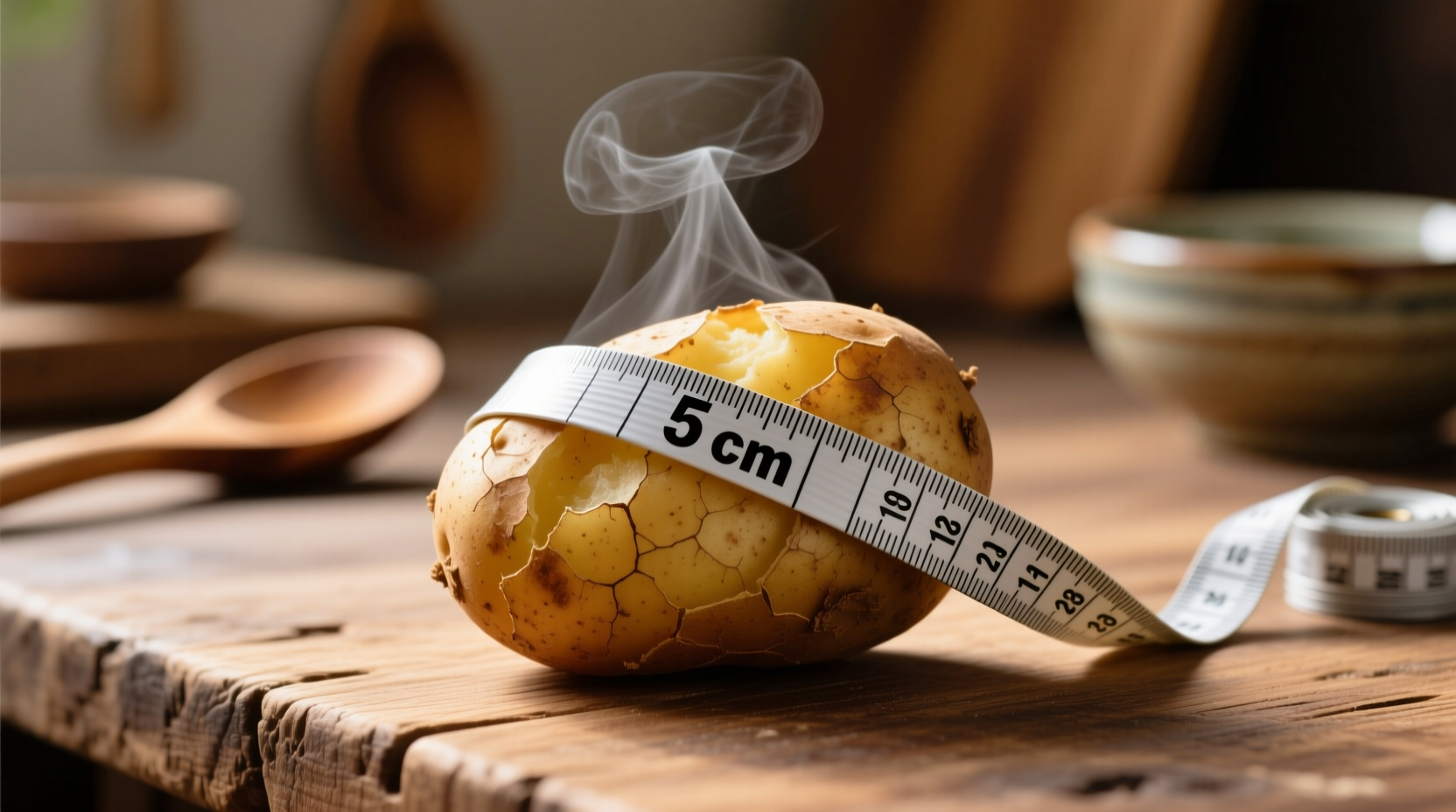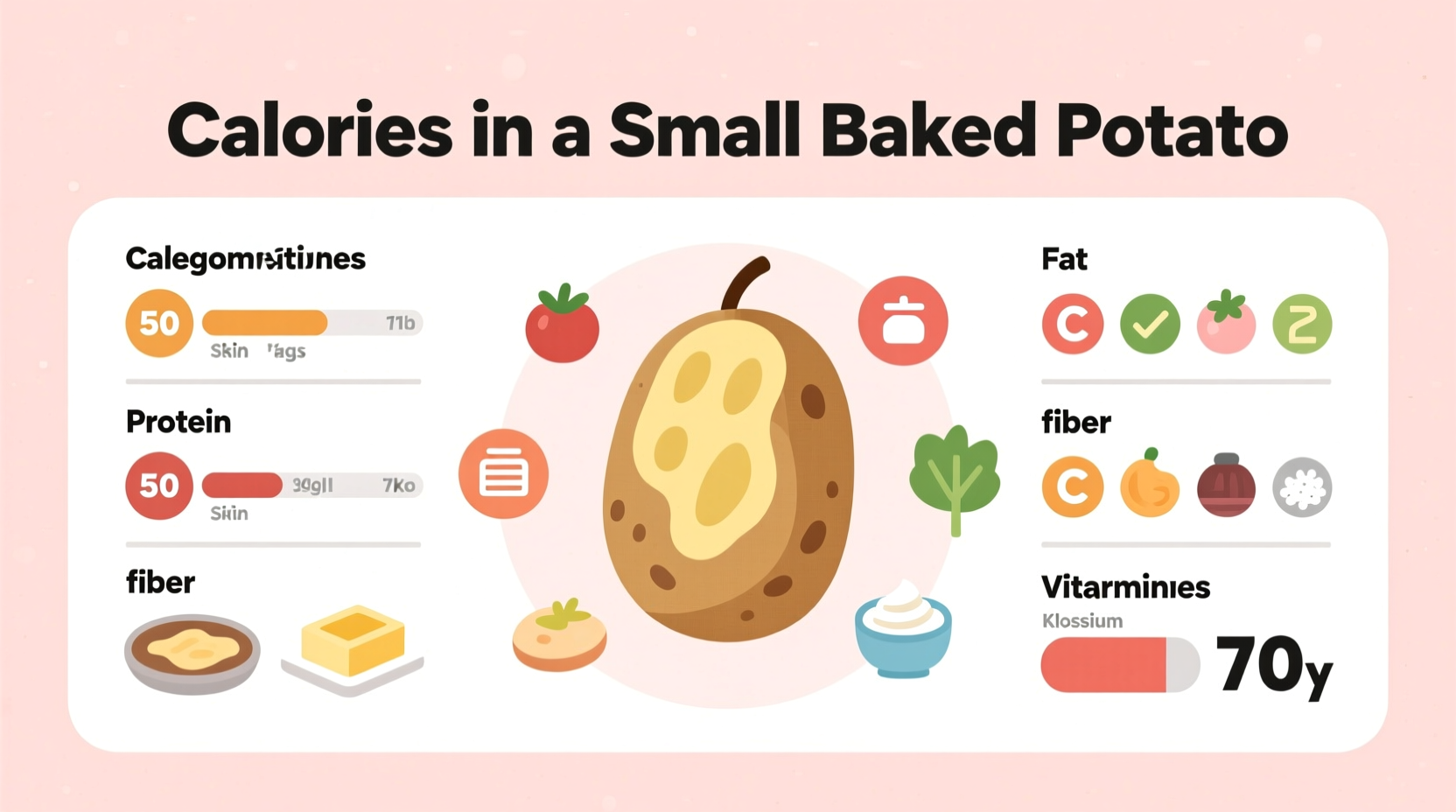Understanding exactly how many calories are in a small baked potato matters whether you're tracking your daily intake, managing dietary goals, or simply making informed food choices. This comprehensive guide delivers precise nutritional information backed by authoritative sources, helping you incorporate this versatile vegetable into your meals with confidence.
What Exactly Qualifies as a "Small" Baked Potato?
Before examining calorie content, we need to clarify what constitutes a "small" baked potato. Many people mistakenly assume all small potatoes contain the same calories, but size variations significantly impact nutritional values.
According to the USDA FoodData Central database, a small baked potato typically weighs approximately 138 grams (about 5 ounces) with skin. This measurement represents a potato roughly 1.5-2 inches in diameter—comparable to the size of a computer mouse or a small fist.
It's crucial to recognize that "small" remains somewhat subjective across different contexts:
- Restaurant portions often define "small" as 4-6 ounces (113-170g)
- Home cooking measurements might consider anything under 6 ounces as small
- Nutrition labels frequently use 138g as the standard small portion

Nutritional Profile of a Small Baked Potato
When prepared plain with skin, a small (138g) baked potato delivers more than just calories. Let's examine the complete nutritional picture based on USDA data:
| Nutrient | Amount | % Daily Value* |
|---|---|---|
| Calories | 134 | 7% |
| Total Fat | 0.2g | 0% |
| Carbohydrates | 30.5g | 11% |
| Dietary Fiber | 2.9g | 10% |
| Protein | 3.0g | 6% |
| Potassium | 535mg | 15% |
| Vitamin C | 17.3mg | 19% |
*Percent Daily Values based on a 2,000 calorie diet. Source: USDA FoodData Central, ID 11013
How Preparation Methods Affect Calorie Content
The calorie count for your small baked potato can change dramatically based on preparation techniques and additions. Understanding these variations helps you make informed choices that align with your dietary goals.
Natural Calorie Variations
Even before adding toppings, several factors influence the calorie content:
- Potato variety: Russet potatoes (most common for baking) contain slightly more calories than red or Yukon gold varieties
- Skin inclusion: Eating the skin adds fiber and nutrients while contributing minimal additional calories (about 10-15 extra calories)
- Moisture content: Potatoes baked at higher temperatures lose more moisture, concentrating calories slightly
Impact of Common Toppings
What you add to your baked potato significantly impacts the total calorie count. Consider these common additions:
- 2 tablespoons sour cream: +52 calories
- 1 tablespoon butter: +102 calories
- 1 ounce cheddar cheese: +113 calories
- 2 tablespoons bacon bits: +26 calories
- 2 tablespoons plain Greek yogurt: +20 calories
These seemingly small additions can transform your 134-calorie potato into a 300+ calorie meal component. For those tracking intake, consider healthier alternatives like steamed broccoli, salsa, or a sprinkle of herbs.
Contextual Boundaries: When Calorie Counts Might Vary
While the USDA provides standardized measurements, real-world variations exist that affect calorie calculations. Understanding these contextual boundaries helps you apply this information practically:
- Measurement methods: Weighing your potato before baking provides the most accurate calorie count, as moisture loss during baking changes the weight
- Regional differences: Potatoes grown in different soil conditions may have slight nutritional variations, though these differences remain minimal for calorie counting purposes
- Seasonal factors: Freshly harvested potatoes contain slightly more moisture (and thus slightly fewer calories per gram) than stored potatoes
- Cooking duration: Longer baking times reduce moisture content, concentrating calories per ounce
For precise tracking, use a kitchen scale with your specific potatoes rather than relying solely on visual size estimates.
Practical Applications for Your Diet
Knowing how many calories are in a small baked potato becomes valuable when applied to real dietary planning. Here's how to incorporate this information effectively:
- Meal balancing: A plain small baked potato fits comfortably within a 400-500 calorie meal when paired with lean protein and vegetables
- Portion control: Using the 138g standard helps prevent unintentional portion creep common with starchy sides
- Dietary flexibility: The high fiber content (nearly 3g) promotes satiety, helping manage overall calorie intake throughout the day
- Nutrient density: Compared to other 130-calorie options, a baked potato delivers significant potassium and vitamin C without added fats
Registered dietitians often recommend baked potatoes as part of balanced eating patterns like the Mediterranean diet. The Academy of Nutrition and Dietetics notes that potatoes provide valuable nutrients often missing in American diets, particularly potassium and fiber.
Comparing Baked Potatoes to Other Common Sides
Understanding how a small baked potato compares to alternative side dishes helps make informed choices:
| Side Dish (Standard Portion) | Calories | Key Nutritional Differences |
|---|---|---|
| Small baked potato (138g) with skin | 134 | High fiber, potassium, vitamin C |
| White rice (1/2 cup cooked) | 102 | Lower fiber, minimal potassium |
| Whole wheat pasta (1/2 cup cooked) | 99 | Higher protein, lower potassium |
| Quinoa (1/2 cup cooked) | 111 | Higher protein, complete amino acids |
| Sweet potato (138g baked) | 112 | Higher vitamin A, similar fiber content |
Source: USDA FoodData Central comparisons
While calorie counts vary slightly, the nutritional profile makes baked potatoes a nutrient-rich choice compared to many alternatives. The naturally occurring fiber and potassium provide benefits beyond simple calorie considerations.
Addressing Common Misconceptions
Several myths persist about potato nutrition that deserve clarification based on current research:
- "Potatoes are fattening": Potatoes themselves contain minimal fat. The perception of potatoes as fattening comes primarily from high-calorie toppings and preparation methods like frying
- "All carbs are bad": The complex carbohydrates in potatoes provide sustained energy and valuable fiber, unlike refined carbohydrates
- "Sweet potatoes are always healthier": Both types offer unique nutritional benefits—regular potatoes provide more potassium while sweet potatoes offer more vitamin A
- "Potato skin is unhealthy": The skin contains nearly half the fiber and significant nutrients—washing thoroughly makes it perfectly safe to eat
Recent research published in the Journal of Nutrition and Metabolism confirms that when prepared healthily, potatoes can be part of effective weight management strategies due to their high satiety value.











 浙公网安备
33010002000092号
浙公网安备
33010002000092号 浙B2-20120091-4
浙B2-20120091-4